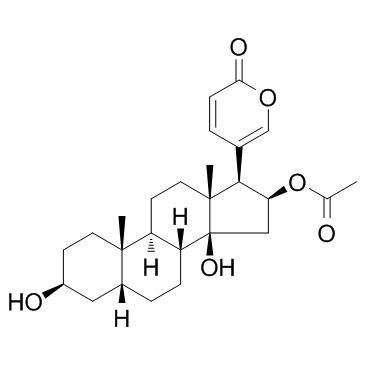Bufotalin (Synonyms: NSC 89596) |
| Catalog No.GC33134 |
Bufotalin is a steroid lactone isolated from Venenum Bufonis with potently antitumor activities. Bufotalin induces cancer cell apoptosis and also induces endoplasmic reticulum (ER) stress activation.
Products are for research use only. Not for human use. We do not sell to patients.

Cas No.: 471-95-4
Sample solution is provided at 25 µL, 10mM.
Bufotalin is a cardiotoxic bufanolide steroid, cardiac glycoside analogue, secreted by a number of toad species; a novel anti-osteoblastoma agent.IC50 value:Target:in vitro: bufotalin induced osteoblastoma cell death and apoptosis in dose- and time-dependent manners. Further, bufotalin induced endoplasmic reticulum (ER) stress activation in osteoblastoma cells, the latter was detected by the induction of C/EBP homologous protein (CHOP), phosphorylation of inositol-requiring enzyme 1 (IRE1) and PKR-like endoplasmic reticulum kinase (PERK), as well as caspase-12 activation [1]. Bufotalin was the most potent active compound among these four bufadienolides, and it exerted stronger inhibitory effect on the viability of doxorubicin-induced multidrug resistant liver cancer cells (R-HepG2) than that of their parent cells HepG2. bufotalin treatment induced cell cycle arrest at G(2)/M phase through down-regulation of Aurora A, CDC25, CDK1, cyclin A and cyclin B1, as well as up-regulation of p53 and p21. Bufotalin treatment also induced apoptosis which was accompanied by decrease in mitochondrial membrane potential, increases in intracellular calcium level and reactive oxygen species production, activations of caspase-9 and -3, cleavage of poly ADP-ribose polymerase (PARP) as well as changes in the expressions of bcl-2 and bax [2]. Bufotalin promoted death receptor-mediated cell death, especially TRAIL-induced apoptosis, through activation of caspase-3 and PARP-1. Cotreatment of bufotalin with TRAIL resulted in the downregulation of anti-apoptotic proteins, including Bcl-XL, Mcl-1, survivin and XIAP, and the up-regulation of MAPKs and TRAIL receptor DR5. In addition, phosphorylation of STAT1 was strongly inhibited by bufotalin [3]. externalization of phosphatidylserine, accumulation of sub-G(1) cells, fragmentation of DNA, and formation of apoptotic bodies were observed in bufotalin-treated Hep 3B cells [4].
[1]. Zhu YR, et al. Bufotalin-induced apoptosis in osteoblastoma cells is associated with endoplasmic reticulum stress activation. Biochem Biophys Res Commun. 2014 Aug 15;451(1):112-8. [2]. Zhang DM, et al. Bufotalin from Venenum Bufonis inhibits growth of multidrug resistant HepG2 cells through G2/M cell cycle arrest and apoptosis. Eur J Pharmacol. 2012 Oct 5;692(1-3):19-28. [3]. Waiwut P, et al. Bufotalin sensitizes death receptor-induced apoptosis via Bid- and STAT1-dependent pathways. Int J Oncol. 2012 Jan;40(1):203-8. [4]. Su CL, et al. Involvement of caspases and apoptosis-inducing factor in bufotalin-induced apoptosis of Hep 3B cells. J Agric Food Chem. 2009 Jan 14;57(1):55-61.
Average Rating: 5 (Based on Reviews and 26 reference(s) in Google Scholar.)
GLPBIO products are for RESEARCH USE ONLY. Please make sure your review or question is research based.
Required fields are marked with *




















